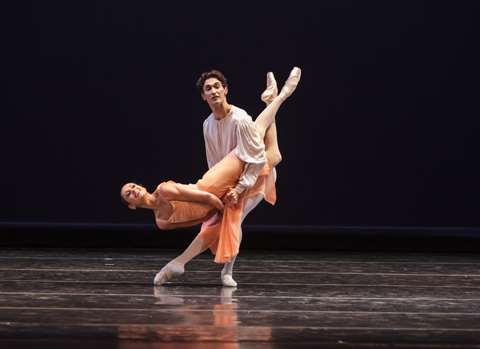
CLASSIC MOVES Putrius and Bauzys perform Balanchine's 'Tchaikovsky Pas de Deux.' [Photo by Thomas Nola-Rion] |
When Festival Ballet Providence started their in-studio series, “Up Close On Hope,” more than 10 years ago, the vision was to give up-and-coming choreographers and dancers a stage less overwhelming and more intimate on which to find their footing. Certainly artistic director Mihailo Djuric’s nurturing of Viktor Plotnikov’s work is a prime example of launching a dancer-turned-choreographer into his next career.
So might be the case for one of the four Festival company members, whose work is featured in the current series, with a range of emotional impact from funny to tragic, thoughtful to satiric. Vincent Brewer’s multi-movement piece, Out of the Box, set to Bach, features six female dancers standing inside oversized shoeboxes and one male dancer slipping his entire reedy body in and out of a much larger box. The variations on the boxes — two feet in; one foot out; making the boxes slide by jumping inside them; balancing them on their feet from a floor position; wearing them on their heads — seemed to correspond to Bach’s variations on his themes. A fun piece to watch and most likely to perform.
The sorrowful Two Sisters, by Vilia Putrius, set to Samuel Barber, is a tribute to dancer Jennifer Ricci’s sister Jaclyn, who died in January, after an illness that forced her to retire from Festival Ballet in 2003. Jaclyn and Jennifer had taken ballet lessons from early childhood and graduated into the company when they were in their teens. This piece shows the two sisters separating three times, when Jaclyn (portrayed by Elizabeth Mochizuki) got married, when she stopped dancing, and when she passed away. And it shows Jennifer thinking back to their earliest days of ballet, as sisters Gabriella and Samantha Shorr represent the Ricci sisters. A tough but healing piece.
Courtney Hanaway’s Dissociative Identity, set to cellist/composer Zoë Keating’s music, features one dancer in a leotard with an abstract pattern on the front, surrounded by six female dancers in various shades of non-patterned purple. The sharp-angled arms and legs, sometimes while upright, sometimes while on the floor, and the interlocking interactions of the dancers gives a fascinating look at the mind of someone enduring multiple personality disorder.
A tongue-in-cheek look at families is cleverly and artfully evoked in Louisa Chapman’s Living Room Vignettes, set to music by pianist/composer Max Richter. A roomy red couch provides a focal point for the antics of the parents and their teenaged daughter, then the older sister and her boyfriend (a breathtaking sequence is when their arms and legs are entwined and moving but never touching) and finally, all five of them.
The other contemporary pieces are Tangata by Boston-based George Birkadze — lots of leg swinging, quick head turns, and sharp poses a la tango — set to Astor Piazzola; Poised, by New York-based Joseph Morrissey, a stunning duet by Alan Alberto and Emily Loscocco; Djuric’s very modern, very abstract Extremes, with original music by Barbara Kolb, also performed with precision and panache by Alberto and Loscocco.